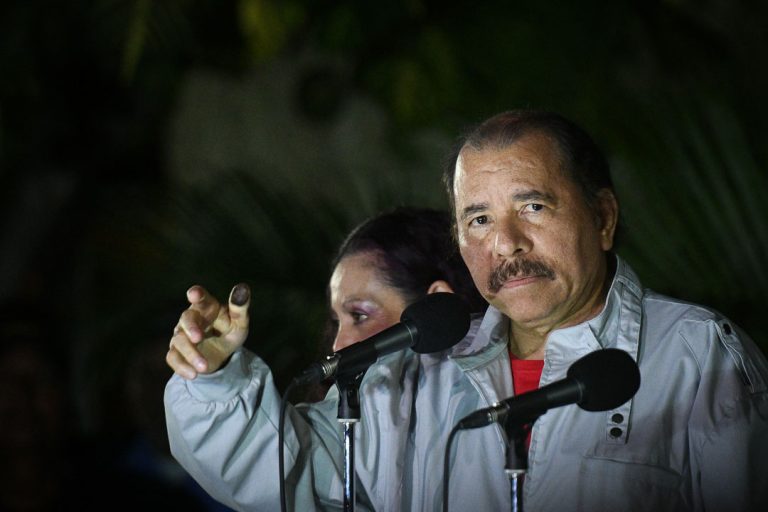9 de noviembre 2016

News About Sheynnis Palacios Not Covered by Media Operating in Nicaragua

PUBLICIDAD 1M
PUBLICIDAD 4D
PUBLICIDAD 5D
The Supreme Electoral Council’s report inverts the numbers: the 70% abstention rate registered by the opposition becomes a participation rate of 68.2%.

Daniel Ortega, el día de las votaciones nacionales de 2016, en las que se reeligió junto con su esposa Rosario Murillo. // Foto: Carlos Herrera | Confidencial
They’re no longer going “towards more victories,” as the campaign slogan proclaimed. The dearth of electoral competition failed to assure a triumphant third consecutive presidential term to Comandante Daniel Ortega, eternal head of the Sandinista Front. In the voting this past Sunday, massive abstention was the winner. The level of abstention was unprecedented even in the local elections, according to data registered by the outlawed opposition, who dedicated themselves to documenting the abstention rate.
“It’s the greatest level of abstention observed in any election over the last thirty years - a massive expression of rejection of the electoral farce,” affirmed Violeta Granera, national coordinator of the Broad Front for Democracy and former vice presidential candidate for the proscribed opposition.
Luis Callejas, coordinator of Citizens for Freedom and former presidential candidate, who was declared illegitimate along with Granera, considers the results of the voting as “a clear and resounding message directed at Daniel Ortega: Nicaraguans are tired of fraud and farces, we wants peace, liberty, and free, transparent, competitive and observed elections.” According to the monitoring conducted by Citizens for Freedom, the abstention rate was over 70%.
Chief magistrate Roberto Rivas, who’s been head of the oft-questioned Supreme Electoral Council for over 20 years, maintains altogether different data. This Monday morning, Rivas appeared before the press to present a preliminary report with 99.8% of the Polling Places tallied. In this report, he assured that 68.2% of Nicaraguans voted and that abstention was even lower than that registered during the 2011 elections.
The lawyer and deposed Liberal Independent Party deputy Eliseo Nuñez declared: “reading between the lines of [the data registered by the opposition], voting day became a referendum, not only on the electoral system but also on President Ortega himself, and it has definitely bathed him in a downpour of illegitimacy.
“The voting stations were empty. People didn’t go out to vote,” Nuñez underlined.
According to Callejas, Nicaragua on Sunday demonstrated that “it has embraced democracy.” “This election with its abstention level isn’t even on a par with a local election, because there was less participation than in a municipal election.”
The official report has been rejected by the opposition organizations and even by the collaborating parties, such as the Liberal Constitutionalist Party (PLC), which disagrees with the reported rate of abstention.
Robert Courtney, executive director of the Civic Ethics and Transparency Group considers that “there’s a very easy way for each Nicaraguan to be a magnificent judge of more or less how the participation went, and it’s to recognize whether they themselves voted, to ask themselves if their family members voted, and how many of their friends voted - or not.” The group that has observed the elections for over two decades still hasn’t presented their calculation of the participation, but in their preliminary commentaries they’ve indicated that participation was “moderate”.
The official statistics from the Supreme Electoral Council allot 72.5% of the votes for the Sandinista Front (FSLN), followed by 15% for the Liberal Constitutionalist Party (PLC); 2.3% for the Conservative Party (PC); 4.3% for the Nicaraguan Liberal Alliance (ALN); 1.4% for the Alliance for the Republic (APRE) and 4.5% for the Independent Liberal Party (PLI).
Official electoral machinery failed
Political analyst Oscar René Vargas, interviewed live Sunday on the television program Esta Semana [This Week], assured that “abstention went even beyond what the polls showed.”
Vargas, who was an advisor to the National Directorate of the FSLN during the eighties, recognizes that on Election Day even the muscle of the official electoral machinery failed. “Many I know had already expressed that they weren’t going to vote, because they didn’t like Rosario Murillo, because things have deteriorated…”
“The fact that the government requires its employees to show their inked finger as proof they voted shows you that there’s also distrust of the FSLN towards how its people are behaving. The Güegüense [satirical figure from seventeenth century Nicaraguan literature] has been recast in the collective imagination of the Sandinista Front and Daniel,” stated Vargas.
According to the expert in Nicaraguan political culture and author of The Syndrome of Pedrarias, [El syndrome de Pedrarias], Ortega had already lost from the moment in which he began to close off the political spaces; when between June and July he ordered the legal representation of the PLI to be snatched from the group led by Montealegre, subsequently deposing 28 opposition deputies; and finally when, he imposed his wife, Rosario Murillo, as Vice Presidential candidate. In Vargas’ judgement she is the source of great rejection and resistance within the very ranks of the government party itself. “From there on, he lost,” was Vargas’ verdict. “For that reason he swept everyone else off the table.”
This article has been translated from Spanish by Havana Times.
Archivado como:
PUBLICIDAD 3M
Periodista. Desde 2003 ha trabajado en medios tradicionales y digitales.
PUBLICIDAD 3D